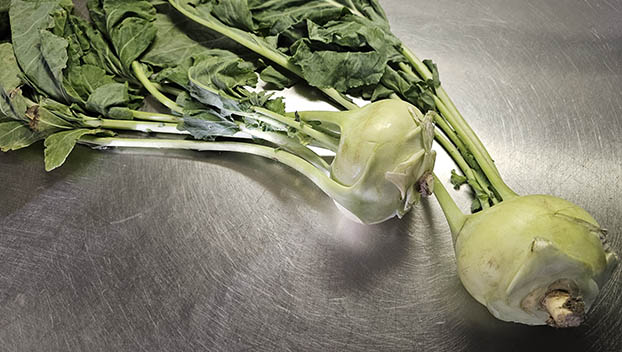Through The Garden Gate: Dinner parties and otherworldly vegetables
Published 6:00 pm Thursday, March 21, 2024

- Kohlrabi is an odd-looking vegetable that can be eaten raw or cooked.
|
Getting your Trinity Audio player ready...
|
In 1972 Ricky Nelson sang about going to a garden party and being disappointed by what happened; he was booed at Madison Square Garden. Several weeks ago, I went to a dinner party where there was a surprising and unexpected conversation, all because the hostess served raw kohlrabi. You know that vegetable; it’s the one that looks like a green alien from outer space.
 Somehow (too many glasses of wine, perhaps? A lengthy lull in the conversation?) talk turned to the scientific classification of that bizarre vegetable that many guests had never eaten. Did it have the same scientific name as broccoli, cauliflower, and cabbage? If so, how could that be? It’s true that they’re all classified as Brassica oleracea, BUT to differentiate them it’s important to use the entire name of each one. Broccoli is Brassica oleracea Italica Group. Kohlrabi is Brassica oleracea Gongylodes Group.
Somehow (too many glasses of wine, perhaps? A lengthy lull in the conversation?) talk turned to the scientific classification of that bizarre vegetable that many guests had never eaten. Did it have the same scientific name as broccoli, cauliflower, and cabbage? If so, how could that be? It’s true that they’re all classified as Brassica oleracea, BUT to differentiate them it’s important to use the entire name of each one. Broccoli is Brassica oleracea Italica Group. Kohlrabi is Brassica oleracea Gongylodes Group.
Broccoli, cauliflower, cabbage, and kohlrabi all have a common ancestor. As this common ancestor made its way to new geographic areas, farmers bred it for the unique characteristics that were most important to them. In China, farmers bred broccoli for slender leafy stems with flower, resulting in gailan, Chinese broccoli. The origin of kohlrabi, however, is murkier. Both Pliny the Elder and Apicius wrote about a Corinthian turnip that resembled kohlrabi. By the 1500s, farmers in northern Europe had developed a brassica with a swollen above ground stem that was probably modern day kohlrabi. It was documented in 1554 by a botanist and was eventually adopted by farmers throughout the Mediterranean, England, and Ireland. It arrived in the United States in the early 1800s.
Trending
Even though Brassicas have been important food crops for centuries and researchers have long been fascinated by the number of very different vegetables produced from a single species, little research has been done on the evolutionary history of Brassicas or their closest living wild relatives. Perhaps that will change now that there’s new RNA sequencing data available.
In the meantime, think of kohlrabi as the jade turnip, which is what the Chinese call it. Cut it into batons and dress it with a spicy mixture of ginger, soy sauce, sesame oil, and Pixian chile paste. The result is a beautiful interplay of pale green and deep red. It’s also true that a well-made Sichuan sauce can disguise the flavor of even the most dreaded Brassica.
And don’t forget to use the entire scientific name when referring to kohlrabi or any of its relatives.
Dr. Cynthia Wood is a master gardener. Her email address is cynthia.crewe23930@gmail.com.





